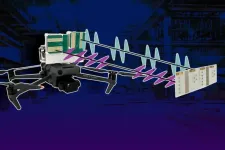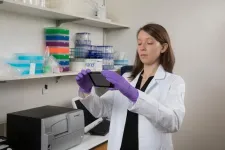(Press-News.org) CAMBRIDGE, MA – In the future, autonomous drones could be used to shuttle inventory between large warehouses. A drone might fly into a semi-dark structure the size of several football fields, zipping along hundreds of identical aisles before docking at the precise spot where its shipment is needed.
Most of today’s drones would likely struggle to complete this task, since drones typically navigate outdoors using GPS, which doesn’t work in indoor environments. For indoor navigation, some drones employ computer vision or lidar, but both techniques are unreliable in dark environments or rooms with plain walls or repetitive features.
MIT researchers have introduced a new approach that enables a drone to self-localize, or determine its position, in indoor, dark, and low-visibility environments. Self-localization is a key step in autonomous navigation.
The researchers developed a system called MiFly, in which a drone uses radio frequency (RF) waves, reflected by a single tag placed in its environment, to autonomously self-localize.
Because MiFly enables self-localization with only one small tag, which could be affixed to a wall like a sticker, it would be cheaper and easier to implement than systems that require multiple tags. In addition, since the MiFly tag reflects signals sent by the drone, rather than generating its own signal, it can be operated with very low power.
Two off-the-shelf radars mounted on the drone enable it to localize in relation to the tag. Those measurements are fused with data from the drone’s onboard computer, which enables it to estimate its trajectory.
The researchers conducted hundreds of flight experiments with real drones in indoor environments, and found that MiFly consistently localized the drone to within fewer than 7 centimeters.
“As our understanding of perception and computing improves, we often forget about signals that are beyond the visible spectrum. Here, we’ve looked beyond GPS and computer vision to millimeter waves, and by doing so, we’ve opened up new capabilities for drones in indoor environments that were not possible before,” says Fadel Adib, associate professor in the Department of Electrical Engineering and Computer Science, director of the Signal Kinetics group in the MIT Media Lab, and senior author of a paper on MiFly.
Adib is joined on the paper by co-lead authors and research assistants Maisy Lam and Laura Dodds; Aline Eid, a former postdoc who is now an assistant professor at the University of Michigan; and Jimmy Hester, CTO and co-founder of Atheraxon, Inc. The research will be presented at the IEEE Conference on Computer Communications.
Backscattered signals
To enable drones to self-localize within dark, indoor environments, the researchers decided to utilize millimeter wave signals. Millimeter waves, which are commonly used in modern radars and 5G communication systems, work in the dark and can travel through everyday materials like cardboard, plastic, and interior walls.
They set out to create a system that could work with just one tag, so it would be cheaper and easier to implement in commercial environments. To ensure the device remained low power, they designed a backscatter tag that reflects millimeter wave signals sent by a drone’s onboard radar. The drone uses those reflections to self-localize.
But the drone’s radar would receive signals reflected from all over the environment, not just the tag. The researchers surmounted this challenge by employing a technique called modulation. They configured the tag to add a small frequency to the signal it scatters back to the drone.
“Now, the reflections from the surrounding environment come back at one frequency, but the reflections from the tag come back at a different frequency. This allows us to separate the responses and just look at the response from the tag,” Dodds says.
However, with just one tag and one radar, the researchers could only calculate distance measurements. They needed multiple signals to compute the drone’s location.
Rather than using more tags, they added a second radar to the drone, mounting one horizontally and one vertically. The horizontal radar has a horizontal polarization, which means it sends signals horizontally, while the vertical radar would have a vertical polarization.
They incorporated polarization into the tag’s antennas so it could isolate the separate signals sent by each radar.
“Polarized sunglasses receive a certain polarization of light and block out other polarizations. We applied the same concept to millimeter waves,” Lam explains.
In addition, they applied different modulation frequencies to the vertical and horizontal signals, further reducing interference.
Precise location estimation
This dual-polarization and dual-modulation architecture gives the drone’s spatial location. But drones also move at an angle and rotate, so to enable a drone to navigate, it must estimate its position in space with respect to six degrees of freedom — with trajectory data including pitch, yaw, and roll in addition to the usual forward/backward, left/right, and up/down.
“The drone rotation adds a lot of ambiguity to the millimeter wave estimates. This is a big problem because drones rotate quite a bit as they are flying,” Dodds says.
They overcame these challenges by utilizing the drone’s onboard inertial measurement unit, a sensor that measures acceleration as well as changes in altitude and attitude. By fusing this information with the millimeter wave measurements reflected by the tag, they enable MiFly to estimate the full six-degree-of-freedom pose of the drone in only a few milliseconds.
They tested a MiFly-equipped drone in several indoor environments, including their lab, the flight space at MIT, and the dim tunnels beneath the campus buildings. The system achieved high accuracy consistently across all environments, localizing the drone to within 7 centimeters in many experiments.
In addition, the system was nearly as accurate in situations where the tag was blocked from the drone’s view. They achieved reliable localization estimates up to 6 meters from the tag.
That distance could be extended in the future with the use of additional hardware, such as high-power amplifiers, or by improving the radar and antenna design. The researchers also plan to conduct further research by incorporating MiFly into an autonomous navigation system. This could enable a drone to decide where to fly and execute a flight path using millimeter wave technology.
“The infrastructure and localization algorithms we build up for this work are a strong foundation to go on and make them more robust to enable diverse commercial applications,” Lam says.
###
This research is funded, in part, by the National Science Foundation and the MIT Media Lab.
END
Engineers enable a drone to determine its position in the dark and indoors
A new low-power system using radio frequency waves takes a major step toward autonomous, indoor drone navigation
2025-02-13
ELSE PRESS RELEASES FROM THIS DATE:
U-M materials scientist, chemical engineer elected into National Academy of Engineering
2025-02-13
Photos
Michigan Engineering professors Elizabeth Holm and Nicholas Kotov are among the newest members of the National Academy of Engineering—one of the highest honors bestowed on engineers in the United States.
"Elizabeth Holm and Nicholas Kotov have not only distinguished themselves as leaders in their fields, they have demonstrated the impact we can have as engineers, influencing how current and future generations of engineers solve problems and do their work," said Karen Thole, the Robert J. Vlasic Dean of Engineering at the University of Michigan College of Engineering.
"We applaud this significant honor, and look forward ...
Evolutionary tradeoffs: Research explores the role of iron levels in COVID-19 infections
2025-02-13
BINGHAMTON, N.Y. -- Your body is ground zero for a cellular arms race.
Your mitochondria, red blood cells and immune system rely on iron to function; so do invading viruses and bacteria. As your body evolves safeguards for this most critical resource, these safeguards select for invaders that can overcome them.
“Iron is physiologically useful in catalyzing reactions, such as binding oxygen, because it both donates and accepts electrons,” explained Binghamton University Associate Professor of Anthropology ...
Ecological Society of America selects 2025 EEE Scholars
2025-02-13
The Ecological Society of America (ESA) announces the 2025 cohort of ESA Excellence in Ecology (EEE) Scholars. This prestigious scholarship program celebrates and supports outstanding early- to mid-career Ph.D. ecologists from groups traditionally underrepresented in the scientific community.
This year’s EEE Scholars are: Elvira D'Bastiani, Postdoctoral Researcher at the University of California, Los Angeles; Gabriela Garcia, Assistant Professor at Northeastern University; Camille Griffith, Assistant Professor at Oglala Lakota College; and Estelí Jiménez-Soto, Assistant Professor at the University of South Florida.
“These exceptional scholars embody ...
U.S. stream network is longer during annual high-flow conditions
2025-02-13
Rivers and streams may look permanent, but their lengths can change dramatically with the seasons, according to a new study. It reports that stream networks in the United States expand up to five times their low-flow size during wet conditions. The findings offer the first large-scale insights into how water dynamically moves through landscapes and provide a framework for forecasting climate-driven changes in stream networks, particularly in response to increasing storminess. Traditionally regarded as ...
Seismic techniques reveal how intense storms in 2023 impacted aquifers in Greater Los Angeles
2025-02-13
Despite record rainfall in the region in early 2023, only a fraction of Southern California’s groundwater reserves has been replenished, researchers report. Their study, which leverages seismic noise data from across Greater Los Angeles, highlights the urgent need for improved monitoring and management of the state’s critical groundwater reserves. After enduring two decades of severe drought, California experienced an abrupt meteorological shift in water in 2023. A succession of 16 atmospheric rivers from late 2022 through early 2023, followed by the torrential ...
Elephant seals in the Pacific serve as deep-ocean sentinels, revealing patterns otherwise hard to measure
2025-02-13
Northern elephant seals may hold the key to unlocking the secrets of the open ocean’s twilight zone (~200 – 1,000 meters deep). According to a new study, these deep-diving creatures can help estimate fish abundance by providing a rare window into the elusive prey dynamics in one of the planet’s most mysterious and remote ecosystems. Ecosystems are dynamic, with resource fluctuations – natural or human-induced – shaping species interactions and food webs. These processes are well studied in terrestrial ecosystems but not in deep, open ocean ecosystems, ...
Depression linked with higher risk of long-term physical health conditions
2025-02-13
Adults with a history of depression gain long-term physical conditions around 30% faster than those without, according to research publishing February 13th in the open-access journal PLOS Medicine. Kelly Fleetwood of the University of Edinburgh, United Kingdom, and colleagues argue that their study suggests depression should be viewed as a ‘whole body’ condition, and integrated approaches should be used to manage mental and physical health.
Depression is the most common mental health condition and ...
Los Angeles groundwater remained depleted after 2023 deluge, study finds
2025-02-13
The greater Los Angeles area has long been subject of intense seismographic monitoring. A network of highly sensitive seismometers peppers the region on a constant vigil for earthquakes. Now researchers at the Stanford Doerr School of Sustainability have developed a new way to use that existing infrastructure and its decades of data to estimate water levels in the region’s aquifers, which serve some 10 million residents of Los Angeles and Orange counties.
The researchers analyzed the ...
Foraging seals enable scientists to measure fish abundance across the vast Pacific Ocean
2025-02-13
EMBARGOED until Thursday, Feb.13, 2025, at 2 P.M. U.S. Eastern Time
SANTA CRUZ, Calif. – Over the past 60 years, marine biologists at UC Santa Cruz have monitored the behavior of northern elephant seals that journey to nearby Año Nuevo Natural Reserve. With the seals gathering on the beach by the thousands to breed and molt, generations of researchers have been able to amass more than 350,000 observations on over 50,000 seals.
With the help of powerful technologies and the intrepidness to get close ...
Dessert stomach emerges in the brain
2025-02-13
To find the cause of the "dessert stomach", the researchers investigated the reaction of mice to sugar and found that completely satiated mice still ate desserts. Investigations of the brain showed that a group of nerve cells, the so-called POMC neurones, are responsible for this. These neurones become active as soon as the mice were given access to sugar which facilitated their appetite.
When mice are full and eat sugar, these nerve cells not only release signaling molecues that stimulate satiety, but also one of the body's own opiate: ß-endorphin. This acts on other nerve cells with opiate receptors and triggers a feeling of reward, ...
LAST 30 PRESS RELEASES:
Myeloma: How AI is redrawing the map of cancer care
Manhattan E. Charurat, Ph.D., MHS invested as the Homer and Martha Gudelsky Distinguished Professor in Medicine at the University of Maryland School of Medicine
Insilico Medicine’s Pharma.AI Q4 Winter Launch Recap: Revolutionizing drug discovery with cutting-edge AI innovations, accelerating the path to pharmaceutical superintelligence
Nanoplastics have diet-dependent impacts on digestive system health
Brain neuron death occurs throughout life and increases with age, a natural human protein drug may halt neuron death in Alzheimer’s disease
SPIE and CLP announce the recipients of the 2025 Advanced Photonics Young Innovator Award
Lessons from the Caldor Fire’s Christmas Valley ‘Miracle’
Ant societies rose by trading individual protection for collective power
Research reveals how ancient viral DNA shapes early embryonic development
A molecular gatekeeper that controls protein synthesis
New ‘cloaking device’ concept to shield sensitive tech from magnetic fields
Researchers show impact of mountain building and climate change on alpine biodiversity
Study models the transition from Neanderthals to modern humans in Europe
University of Phoenix College of Doctoral Studies releases white paper on AI-driven skilling to reduce burnout and restore worker autonomy
AIs fail at the game of visual “telephone”
The levers for a sustainable food system
Potential changes in US homelessness by ending federal support for housing first programs
Vulnerability of large language models to prompt injection when providing medical advice
Researchers develop new system for high-energy-density, long-life, multi-electron transfer bromine-based flow batteries
Ending federal support for housing first programs could increase U.S. homelessness by 5% in one year, new JAMA study finds
New research uncovers molecular ‘safety switch’ shielding cancers from immune attack
Bacteria resisting viral infection can still sink carbon to ocean floor
Younger biological age may increase depression risk in older women during COVID-19
Bharat Innovates 2026 National Basecamp Showcases India’s Most Promising Deep-Tech Ventures
Here’s what determines whether your income level rises or falls
SCIE indexation achievement: Celebrate with Space: Science & Technology
Children’s Hospital Colorado performs region’s first pediatric heart and liver dual organ transplant
Australian team discover why quantum computers have memory problems over time
What determines the fate of a T cell?
Candida auris: genetic process revealed which could be treatment target for deadly fungal disease
[Press-News.org] Engineers enable a drone to determine its position in the dark and indoorsA new low-power system using radio frequency waves takes a major step toward autonomous, indoor drone navigation




